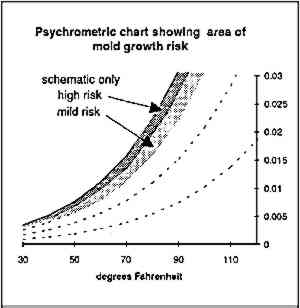EFFECTS OF CLIMATE CONTROL ON THE MUSEUM BUILDING ENVELOPEWILLIAM ROSE
5 DAMAGEData are available showing the conditions of temperature and humidity under which damage to materials can occur (Nicholas 1973). One such kind of damage is from mold, which may grow where the relative humidity at the surface is around 80% or above. As with the sorption isotherm chart (fig. 3), the data can be extracted from the chart and used to estimate zones of mold growth (fig. 8). This example does not use varying moisture content at the surface as a parameter of growth, but such information could be used to plot lines of constant growth rates with their associated risk.
It has been suggested (Michalski 1991) that environmental conditions for artifacts should be described using damage risk associated with that set of conditions. Psychrometric plotting of potential damage conditions can achieve this goal. |
